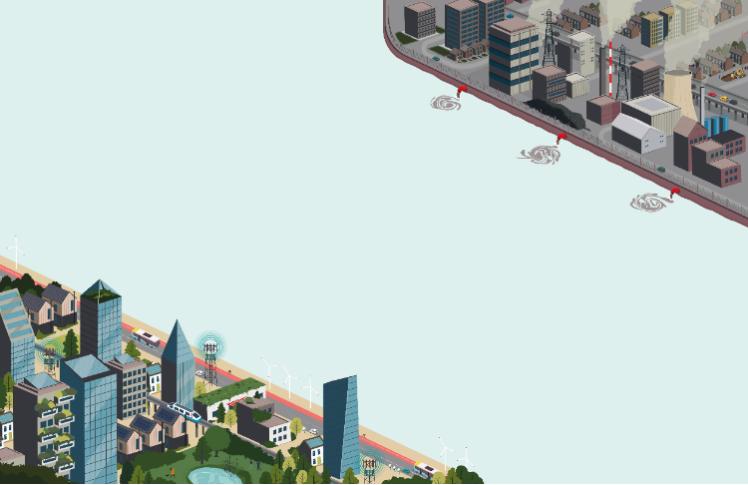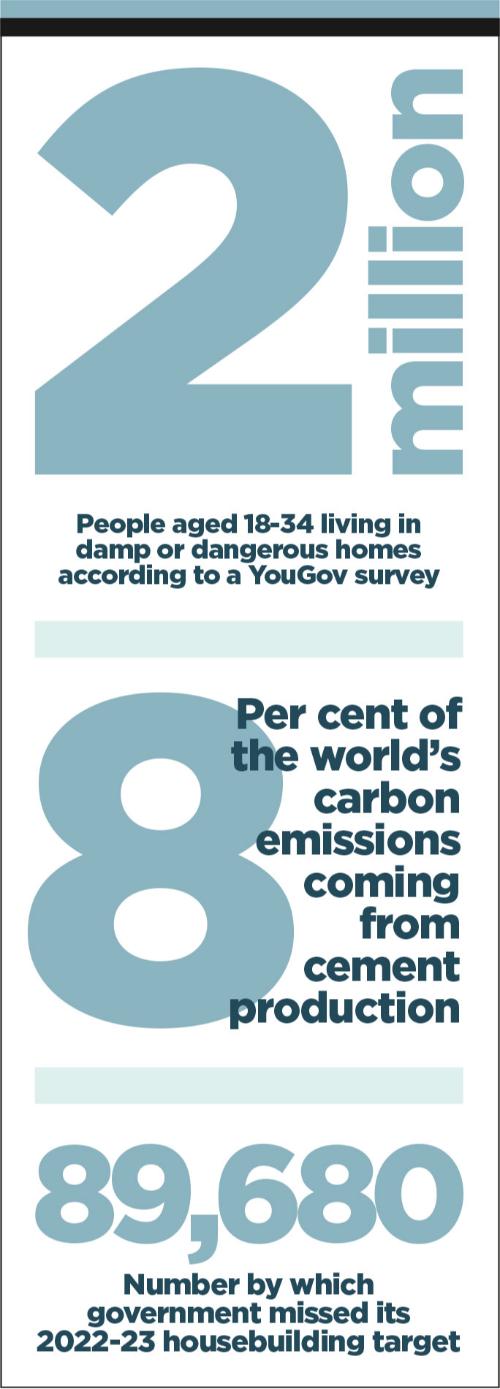Salvaging the future: why Britain must build sustainably
Construction in London (Credit: Marcin Rogozinski / Alamy Stock Photo)
10 min read
Britain has a housing crisis but building our way out of it will make it still harder to meet climate change targets. Justine Smith explores what can be done to provide enough homes at the least environmental cost. Illustration by Tracy Worrall
More than six million people are stuck in unaffordable, poor quality or inappropriate accommodation, according to Shelter.
Both main parties agree the country needs at least 300,000 new homes a year to tackle this crisis.
Labour leader Keir Starmer, sensing a political opportunity created by the government’s failure to meet this target, has promised to “bulldoze” planning regulations and build a series of new towns.
But such a sustained building drive could be disastrous for the environment and still fail to effectively tackle critical shortages of decent, affordable and sustainable housing, warn experts.
The construction and demolition trade is one of the world’s greatest polluters. Climate damage from the concrete, bricks, steel and glass to deliver 300,000 homes a year would be equal to around 30m annual flights from London to New York.
As well as embodied carbon, construction materials come with a damaging legacy of embodied ecological impact – damage to nature generated from extraction at source through processing, manufacturing and transportation, construction and useful life, through to demolition and disposal.
We have only ever built homes on that scale when the state has played an active role
“Business-as-usual construction on the scale needed to meet housing need through new builds would smash through our carbon quotas, not to mention the potentially devastating impact on nature,” says Kai Liebetanz, senior adviser at the United Kingdom Green Building Council (UKGBC).
“The UK’s record on both is already one of the world’s worst. We are in the bottom 10 per cent of countries in the Natural History Museum’s biodiversity intactness index, having lost almost half of our species, and the Climate Action Tracker downgraded the UK from ‘almost sufficient’ to ‘insufficient’ this September after the government weakened a number of its environmental policies.”
To minimise environmental impact, campaigners are calling for policymakers to develop a far more detailed and regulated strategy, looking at different ways to upgrade and make full use of existing stock while ensuring the right sort of new housing is built in the places it is most needed using sustainable materials with minimal carbon emissions.
“The need for new housing supply is non-negotiable,” says Alex Diner, a senior researcher at the New Economics Foundation. “We have shocking levels of housing need in this country defined by homelessness, overcrowding, unaffordability and poor quality housing stock.
“The annual target of 300,000 new dwellings is a good start but it needs to include at least 90,000 social homes. We have only ever built homes on that scale when the state has played an active role and invested in social homes alongside the right infrastructure. There is little incentive for developers, most of them large scale, to deliver adequate numbers of high quality social and affordable housing in places people actually want to live.
“If you allow developers to take advantage of relaxed planning laws without care for sustainability or housing needs, we will not get close to solving the housing crisis.”
The Malaysian investors behind the ongoing £9bn Battersea Power Station development in central London, one of the biggest in Europe, managed to downsize their initial offering of 636 “affordable” homes, from the overall 4,239 homes planned for the site, to just 386 after building started. No social housing was required as part of the planning consent, despite local council Wandsworth registering 3,500 families as statutory homeless.
Angela Rayner, Labour’s shadow deputy prime minister and shadow secretary of state for levelling up, housing and communities, has vowed to stop developers “wriggling out” of their responsibilities.
“There is a distinction between so-called affordable housing and social housing,” says Ellie Chowns, the Green Party’s parliamentary candidate for North Herefordshire and housing spokesperson. “We need far more social rented housing. Since the mass sell-off of council homes we’ve had a massive transfer out of the social housing market into the private market with much higher rents and the transfer of money from the public purse into the pockets of private landlords.
 Illustration: Tracy Worrall
Illustration: Tracy Worrall
“We want at least 100,000 new council homes built to Passivhaus [a building formula which uses passive energy sources such as solar and household appliances, and uses insulated yet breathable construction] or equivalent carbon net-zero standard being built a year. Large-scale Passivhaus building needs a spending uplift of four to eight per cent on smaller homes which is a small additional cost in light of the sorts of profits that large developers are raking in.”
The UK’s existing stock – which will make up 80 per cent of all accommodation in 2050 when we need to reach net-zero – is highly inefficient, currently accounting for 30 to 40 per cent of energy consumption and up to a third of energy-related greenhouse gas emissions, two-thirds of that from drafts and leaks. Under 2050 targets, it would use 92 per cent of our carbon quotas plus an extra 12 per cent for post-2023 builds.
A mass retrofitting programme to decarbonise old housing stock with extra insulation, renewable energy, double glazing and heat pumps, is therefore key to meeting targets. However critics say the government has failed to get on top of the issue, leaving a mountain to climb.
It has scrapped plans to force landlords to upgrade private rented property and underspent in its modest £6.6bn five-year retrofitting budget by £2bn.
Chowns points out: “Last year we had the government putting £40bn into fuel bill subsidies which went up chimneys and into the pockets of the large energy companies. Imagine how many homes could have been insulated and upgraded, saving energy and emissions and bringing down household bills.”
Labour has vowed to spend almost 10 times more per year – £60bn over a decade – on grants and loans to retrofit 19m homes and to train a new workforce to help plug huge skills gaps that have held up progress so far.
The New Economics Foundation says another way to boost depleted social housing stock with minimal fallout would be to enable local authorities to buy empty and poorly maintained homes and retrofit them.
Diner says: “Many landlords would be happy to be sell as they struggle to fetch rents to meet higher mortgages. It makes economic sense as well as being more environmentally sustainable.”

At last count there were 676,304 empty homes in the UK, 248,149 vacant for more than six months, and 2.4m more low quality and poor energy-efficient properties. The Fabian Society estimates such an acquisitions programme could deliver half a million affordable or social homes over 10 years.
Diner suggests the government could start by recovering and redirecting the Department for Levelling Up, Housing and Communities’ £1.9bn underspend from 2022 to 2023 to buy and upgrade as many homes as possible.
We could also stop demolishing buildings that still have a useful life. We currently knock down 50,000 buildings a year, a large proportion from council housing estates which could be upgraded for a fraction of the price.
“There are about 1.4m council homes left, most built 50 to 70 years ago, and many are not in a good state,” says Andy Bates, an executive member of the Labour Housing Group. “But it makes economic and environmental sense to bring them up to standard instead of replacing them.
“It costs about £400,000 to build a new house in inner London. You could upgrade the average council home there and make it net-zero for £100,000.”
Where new builds are necessary, regulation could minimise the embodied carbon and ecological impact of all new UK construction, reduce waste and encourage a circular economy, where all salvageable materials are reused and minimal new materials are needed.
Almost two-thirds of all waste produced in the UK comes from construction and demolition, 120m tonnes a year, about 12m large skip-loads.
The government claims 90 per cent of that is recovered but most is crushed into aggregate and laid under roads and other surfaces.
“Not all approaches to reuse are equal,” says Chowns. “One that reuses a material in its original form rather than crushing it up into an aggregate is clearly going to be more energy efficient. We need to consider these aspects with every dimension of the construction process.”
Morgan Lewis is CEO of Material Index, a UK digital platform for surveying existing buildings and selling their valuable components when they are demolished or refurbished. His company helps recover and resell 19 per cent of building components ranging from light fittings to steel beams. The average site only sees two per cent recovery.
He says: “There is a misconception that it always costs more to separate waste materials and sell them for reuse.
“Where once renewable energy was more expensive than fossil fuels, now the reverse is true. Government can promote a circular economy supply chain. London has done a great job in this regard. As demand and supply chains grow, we will see more and more materials coming back into the market. This will help make reused materials a preferred first option for developers.
“Digitalisation has enabled a booming sharing economy, with sites like Airbnb and Ebay connecting buyers and sellers. We are doing the same with used construction materials.”
A spokesman for the Mayor of London, Sadiq Khan, says the capital is leading the way in sustainable construction.
“The mayor’s London Plan introduced two groundbreaking policies – Whole Life-Cycle Carbon Assessments and Circular Economy Statements – setting out how they will incorporate circular economy thinking into the construction and operation of proposed developments,” they explain.
“This is to support reductions in waste and carbon emissions. Developers must demonstrate how they are using 20 per cent recycled or reused content.”
The UK bought 2.5bn bricks last year and demolished 2.3bn, most of which will now be buried rubble. Yet bricks can easily be recovered and prepared for reuse.
The sand with which they are built is often dredged from rivers or the sea, damaging ecosystems. Brick kilns can cause health problems for workers, who are often exploited, and the environmental cost of transporting the bricks in such numbers must be considered.
“People think they only need to think about the carbon footprint of keeping our buildings running, which is not true,” says Liebetanz.
“A lot of the impact comes from building materials even though only one to two per cent of the Earth’s surface is occupied by human settlement.
“It’s a whole supply chain issue and it’s incredibly hard to get data on that. There are voluntary international frameworks whereby responsible developers show accountability for transparency around the origins and impact of their materials. If that became law, it would go a long way towards minimising environmental damage.”
A government spokesperson says: “The UK is already a world leader when it comes to reducing carbon emissions but we are making sure future homes will be net-zero ready and are implementing new standards so that homes built from 2025 produce 75 to 80 per cent less carbon emissions than homes built under the current building regulations.
“Our long-term housing plan will also support our ambition to deliver 300,000 homes per year, and we are on track to meet our manifesto commitment of building 1m homes this Parliament.”
